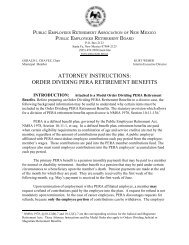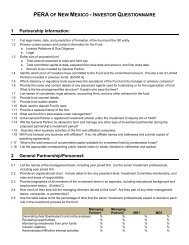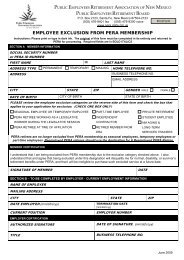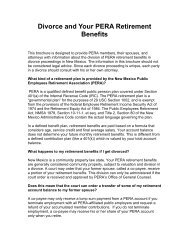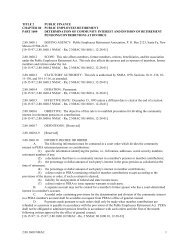June 27, 2013 - Public Employees Retirement Association of New ...
June 27, 2013 - Public Employees Retirement Association of New ...
June 27, 2013 - Public Employees Retirement Association of New ...
Create successful ePaper yourself
Turn your PDF publications into a flip-book with our unique Google optimized e-Paper software.
PERA Executive Investment Summary<br />
May <strong>2013</strong><br />
Monthly Outlook: ‘Terra Incognita’<br />
Over the course <strong>of</strong> the perilous climb out <strong>of</strong> the depths <strong>of</strong> the dark recession to the economic recovery<br />
during the last few years, the U.S. Federal Reserve’s fiscal policies and practices <strong>of</strong> quantitative easing<br />
(QE) have taken various twists and turns leading to a grey area <strong>of</strong> terra incognita (Latin: ‘uncharted<br />
territory’). The Fed has worked tirelessly since 2009 to provide unprecedented interest rate<br />
accommodations bringing the rates to negative real levels and creating extensive liquidity injections to<br />
stimulate the American economy. They have committed to battling deflation and held fast against<br />
economic slippage by purchasing billions <strong>of</strong> dollars <strong>of</strong> debt and risky mortgage assets through a buy-back<br />
program. Currently, the Fed is buying $85 billion <strong>of</strong> Treasuries and mortgage-back securities each month<br />
in order to put downward pressure on borrowing costs and to help spur economic growth. The average<br />
economic recovery expansion <strong>of</strong> a post-war period typically lasts 63-65 months. The U.S. is currently in<br />
the 47 th month <strong>of</strong> the current economic recovery, assisted by the bond purchasing program; the bond<br />
purchasing program that was never intended to be permanent, but as an emergency measure. Gauging<br />
the full impact <strong>of</strong> Quantitative Easing (QE) measures has required a steel reserve <strong>of</strong> calm and patience.<br />
In an attempt to foster a longer-term view for the remainder <strong>of</strong> the recovery and finding new techniques<br />
to keep inflation low while paring back on aggressive monetary stimulation, the Fed has taken on the<br />
discussion <strong>of</strong> tapering at their monthly bond purchases. Chairman Ben Bernanke told Congress’s Joint<br />
Economic Committee on May 22 nd that the Fed ‘could scale back stimulus efforts in the next few<br />
meetings’ if the employment outlook shows ‘sustainable’ improvement. He emphasized that any decision<br />
would hinge upon the economic data and that the Fed is prepared to stop tapering or even reverse it, if<br />
economic growth does not meet expectations.<br />
On <strong>June</strong> 18 th & 19 th , the Federal Open Market Committee met to focus on when and how they will tackle<br />
the process <strong>of</strong> retracting the QE and continuing the deleveraging process. The Fed has stated an<br />
unemployment rate <strong>of</strong> 6.5% as its threshold for pulling back on monetary policy. This level is interpreted<br />
as a healthy position in the recovery <strong>of</strong> the housing market and the economic impact <strong>of</strong> an improved<br />
labor market. At which time a reduction or ‘tapering’ <strong>of</strong> the bond purchase program should be<br />
implemented as an act <strong>of</strong> confidence in economic strength. Economic data has shown signs <strong>of</strong> a steady<br />
recovery in the U.S., which has led to robust discussions among Fed <strong>of</strong>ficials. The current talks have<br />
tentatively considered paring back the purchases from $85 billion to $65 billion per month possibly<br />
beginning in October, and eventually to $45 billion per month in late 2014. The steady decline in easing<br />
would last through 2015 in order to alleviate any potential spikes <strong>of</strong> inflationary reaction to the Fed’s<br />
attempts at a smooth adjustment. Since a reduction in bond purchases hinges upon the unemployment<br />
rate, movement towards the 6.5% threshold has been rather painfully slow thus far. The stock market<br />
and the housing market are resurgent and job market participation has been inching up, but the<br />
unemployment rate is still uncomfortably high. Even the most optimistic <strong>of</strong> economists hold the 6.5% rate<br />
as a target further out in the 2014 & 2015 calendar than the Fed. Importantly, once the tapering has<br />
been completed, only then will the Fed consider reassessing the interest rate and a possible move to<br />
increase it for the first time since 2006.<br />
The speculation over the unknown outcome <strong>of</strong> the discussions have led investors to recalibrate their<br />
interest rate expectations and outlook in various markets; domestic, international and in particular,<br />
emerging. Jim O’Neill, formerly <strong>of</strong> Goldman Sachs, has stated that concerns over changing Fed policy are<br />
especially front-and-center for emerging market investors. The global bond market stands to be exposed<br />
to high levels <strong>of</strong> market instability particularly for those countries with excessive account deficits and<br />
uncertainty over resolving them. Turkey, India, Brazil, South Africa, Indonesia and Thailand have all<br />
begun to feel the mounting volatility over U.S. interest rates. The market chatter over the Fed’s tapering<br />
process is leading to rising Treasury yields and strengthening USD, which is contributing to the early<br />
demise <strong>of</strong> the ‘great reach for yield’ trades which propped up the Emerging Markets. The emerging<br />
6




